
The Batrachedridae are a small family of tiny moths. These are small, slender moths which rest with their wings wrapped tightly around their bodies.

The Blastobasidae are a family of moths in the superfamily Gelechioidea. Its species can be found almost anywhere in the world, though in some places they are not native but introduced by humans. In some arrangements, these moths are included in the case-bearer family (Coleophoridae) as subfamily Blastobasinae. The Symmocidae are sometimes included in the Blastobasidae as subfamily or tribe.

The Momphidae, or mompha moths, is a family of moths with some 115 described species. It was described by Gottlieb August Wilhelm Herrich-Schäffer in 1857. These moths tend to be rather small with a wingspan of up to 21 mm. The wings are held folded over the body at rest. The larvae are concealed feeders, either as leaf miners or within seeds or stems.
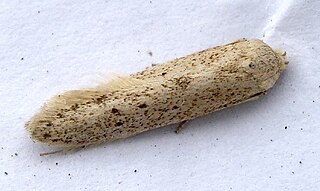
Blastobasis is the type genus of the gelechioid moth family Blastobasidae; in some arrangements these are placed in the case-bearer family (Coleophoridae) as a subfamily. Within the Blastobasidae, the subfamily Blastobasinae has been established to distinguish the Blastobasis lineage from the group around Holcocera, but the delimitation is not yet well-resolved.
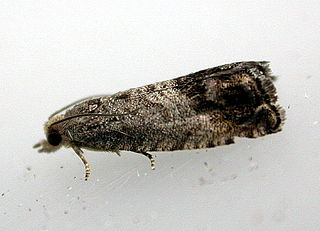
Cydia splendana, the chestnut tortrix, is a moth of the family Tortricidae. It is found in Europe. It is also known as the acorn moth, but this can also refer to Blastobasis glandulella from North America, which belongs to the more primitive family Blastobasidae.

Blastobasis adustella is a species of moth of the family Blastobasidae. It is endemic to Australian region, but was introduced in western Europe and is now reported from The Netherlands, Great Britain, Ireland, Madeira and the Azores
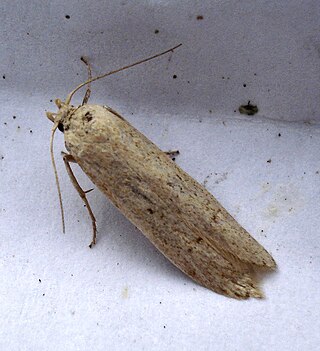
Blastobasis lacticolella is a species of moth of the family Blastobasidae. It was introduced to western Europe and is now reported from the Netherlands, Great Britain, Ireland and Madeira.
Blastobasis phaeopasta is a moth of the family Blastobasidae. It is found in Australia, including northern Queensland. It was first described in 1947 by Alfred Jefferis Turner, and the species epithet, phaeopasta, describes it as being "darkly sprinkled".

Anatrachyntis rileyi, the pink cornworm, pink bud moth or pink scavenger, is a species of moth of the family Cosmopterigidae, the cosmet moths. It was first described by Lord Walsingham in 1882 from the southern United States, but it is probably an introduction to North America. It is found in much of the warm or tropical areas of the world, including northern Australia, the Galápagos Islands, Hawaii, the Antilles, South America and Mauritius.
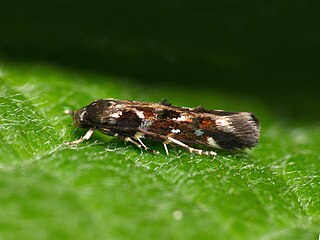
Mompha terminella is a moth in the family Momphidae found in Europe and North America.
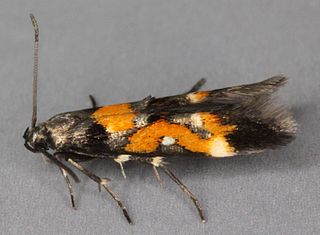
Mompha locupletella is a moth in the family Momphidae that can be found in the Palearctic including Europe.
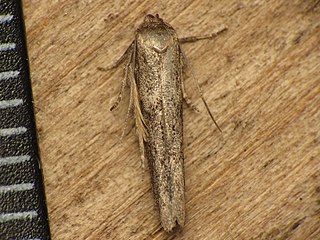
Blastobasis phycidella is a moth in the family Blastobasidae. It is found in most of Europe.

Blastobasis marmorosella is a moth in the family Blastobasidae. It is found on the Canary Islands, Madeira and in Portugal and Spain. This species has been accidentally introduced to Australia and New Zealand.
Blastobasis maroccanella is a moth in the family Blastobasidae. It is found on the Azores, Madeira and in Portugal, Spain and Morocco. It was recently reported from California in the United States.
Blastobasis ochreopalpella is a moth in the family Blastobasidae. It is found on Madeira.
Blastobasis rebeli, the marsh dowd moth, is a moth in the family Blastobasidae found on Madeira. It was first recorded from Hampshire, Great Britain in 1998 and there have been subsequent records from the same area and nearby, as well as in West Sussex.
Trichophaga robinsoni is a moth of the family Tineidae. It is found on the Canary Islands, the Selvagens Islands and Madeira. It has also been recorded from Asia minor, Saudi Arabia, Yemen, Tunisia, Egypt, Sudan, Somalia, the Central African Republic and the Democratic Republic of Congo. There is also a record for Fiji.












